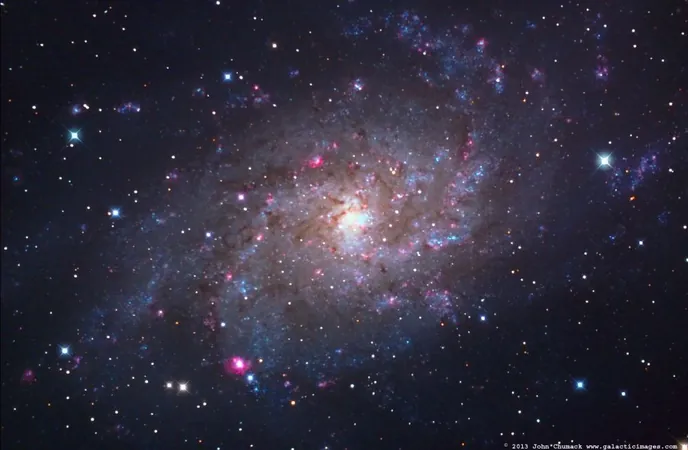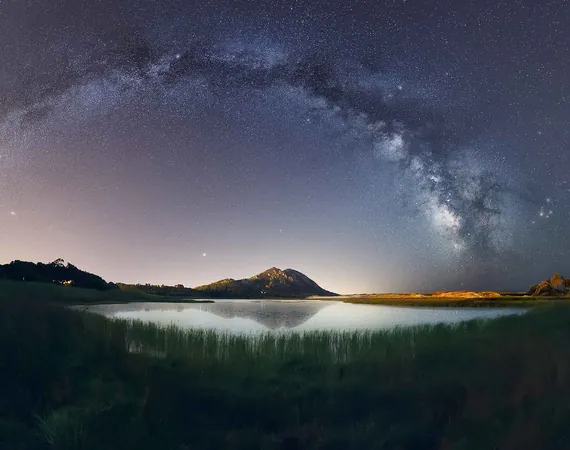
Webb's Groundbreaking Discovery: 43 Supernova Remnants Captured in the Triangulum Galaxy!
2024-10-25
Author: Jia
Introduction
Astronomers have taken a giant leap toward understanding the mysteries of the Universe with groundbreaking infrared observations made by the James Webb Space Telescope (JWST). A recent study led by Ohio State University researchers has unveiled intricate details about 43 supernova remnants (SNRs) located in the Triangulum Galaxy (Messier 33). This revelation opens the door to an entirely new realm of astrophysical research, providing insights that have eluded scientists due to previous observational limitations.
Historical Context
Historically, studies of SNRs have predominantly focused on our Milky Way galaxy and its close companions, the Magellanic Clouds. The constraints imposed by earlier infrared observatories left a vast expanse of the cosmos unexplored in terms of supernova remnants, thereby limiting our understanding of these cosmic fireworks. However, JWST's advanced capabilities allow astronomers to explore this phenomenon in distant galaxies, where they anticipate uncovering new statistical data that can transform our knowledge of star explosions.
Significance of the Findings
Dr. Sumit K. Sarbadhicary, who led the study, emphasized the significance of their findings: "We are stepping outside the confines of the Magellanic Clouds for the first time to explore SNRs in other galaxies like Triangulum. There's enormous potential to learn more about dust production, supernova compositions, and the dynamics of shock waves that play crucial roles in star formation."
Advancements in Technology
The initial generation of studies on SNRs was conducted by earlier missions like NASA's Infrared Astronomical Satellite (IRAS) and the ESA's Infrared Space Observatory (ISO), which, despite their successes, were limited in spatial resolution. Subsequent missions like Spitzer and Herschel improved upon this, but still fell short in terms of detail for distant galaxies. That was until JWST arrived, with a resolution and sensitivity unmatched by its predecessors.
New Discoveries
In this latest study, researchers utilized archival JWST observations that spanned several key regions in the Triangulum Galaxy. Incredibly, these observations have revealed molecular hydrogen emissions in several supernova remnants—a first for extragalactic sources. This is pivotal because such emissions are linked to the conditions necessary for star formation, indicating potential future star birth in these energetic environments.
Exciting Ratios
Astronomers are particularly excited about the ratio of infrared-emitting SNRs uncovered, with preliminary estimates indicating that between 14-43% show visible radiation in the infrared spectrum. According to Dr. Sarbadhicary, the brightest infrared SNRs tend to be small yet powerful, emitting energy due to the shock waves generated during supernova explosions impacting dense interstellar material. This discovery underscores the role that shocks play in regulating star formation across galaxies.
Broader Implications
Beyond the Triangulum Galaxy, the implications of this research extend to numerous neighboring galaxies within the Local Group, including prominent ones like Andromeda (M31) and the Southern Pinwheel Galaxy (M83). Sarbadhicary notes, "The potential for groundbreaking work is tremendous as we look into understanding how supernovas affect their environments and contribute to the cycle of star formation."
Conclusion
As astronomers eagerly analyze the data collected by JWST, the excitement surrounding these observations is palpable within the scientific community. It signals a new era of astrophysical exploration, where the secrets of supernova remnants may finally begin to reveal themselves on a cosmic scale. The findings highlight not just the capabilities of JWST but also emphasize the endless mysteries of the Universe waiting to be unraveled. Stay tuned, as the next chapters in this cosmic narrative unfold!



 Brasil (PT)
Brasil (PT)
 Canada (EN)
Canada (EN)
 Chile (ES)
Chile (ES)
 España (ES)
España (ES)
 France (FR)
France (FR)
 Hong Kong (EN)
Hong Kong (EN)
 Italia (IT)
Italia (IT)
 日本 (JA)
日本 (JA)
 Magyarország (HU)
Magyarország (HU)
 Norge (NO)
Norge (NO)
 Polska (PL)
Polska (PL)
 Schweiz (DE)
Schweiz (DE)
 Singapore (EN)
Singapore (EN)
 Sverige (SV)
Sverige (SV)
 Suomi (FI)
Suomi (FI)
 Türkiye (TR)
Türkiye (TR)